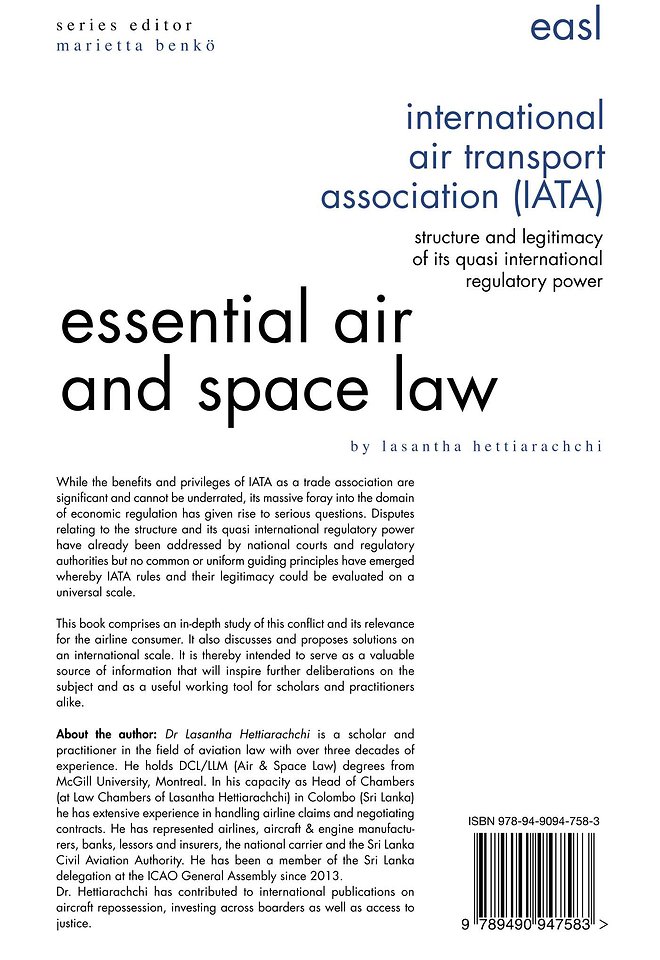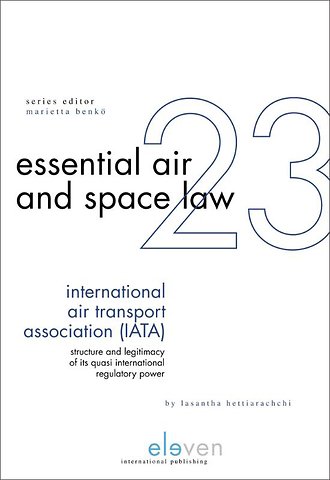



Dr Lasantha Hettiarachchi is a scholar and practitioner in the field of aviation law with over three decades of experience.
Meer over Lasantha HettiariachchiInternational Air Transportation Association (IATA)
Structure and Legitimacy of its Quasi International Regulatory Power
Samenvatting
While the benefits and privileges of IATA as a trade association are significant and cannot be underrated, its massive foray into the domain of economic regulation has given rise to serious questions. Disputes relating to the structure and its quasi international regulatory power have already been addressed by national courts and regulatory authorities but no common or uniform guiding principles have emerged whereby IATA rules and their legitimacy could be evaluated on a universal scale.
This book comprises an in-depth study of this conflict and its relevance for the airline consumer. It also discusses and proposes solutions on an international scale. It is thereby intended to serve as a valuable source of information that will inspire further deliberations on the subject and as a useful working tool for scholars and practitioners alike.
Trefwoorden
Specificaties
Inhoudsopgave
Chapter 1 Introduction and Overview 1
1.1 Overview of International Air Transport Regulation 1
1.2 The Basis for a Logical and Transparent Regulatory Structure 3
1.3 Regulatory Interface and the Consumer 6
1.4 Economic Regulations and the Emergence of IATA 7
1.5 The Founding and History of IATA 8
1.6 Independence of IATA and Its Rule-Making 9
1.7 Rule-Making Structure 10
1.8 Hierarchy of Bodies Within IATA 12
1.8.1 The Act of Incorporation of IATA 12
1.8.2 IATA Articles of Association 15
1.8.3 The General Meeting and Board of Governors 17
1.8.4 The Director General of IATA 21
1.8.5 Amendment of Articles and Dissolution 21
1.8.6 Meetings of Members and the Board 21
1.8.7 IATA Traffic Conferences 22
1.8.8 Services Conferences (Passenger and Cargo) 22
1.8.9 Agency Conferences (Passengers and Cargo) 23
1.8.10 Tariff Coordinating Conferences 23
1.9 Early Functions of IATA 24
1.9.1 Agreeing on Fares and Rates 25
1.9.2 Traffic Documents 25
1.9.3 Interline Agreements 26
1.9.4 Administration of Sales Agents 26
Chapter 2 Rule-Making Authority and Regulatory History 29
2.1 Rule-Making Authority of IATA 29
2.2 Is the Legislative Authority of IATA ‘Delegated’? 36
2.3 Tariff Coordination and Regulatory Oversight 44
2.4 Approval of IATA Tariffs in the United States 45
2.5 Civil Aeronautics Board and IATA 49
2.6 CAB Debate and Historical Rationale Adopted to Grant Approval to IATA 50
2.7 Illustrations of CAB Intervention and Orders Relating to IATA Resolutions 53
2.8 The CAB Show Cause Order and Its Repercussions 61
2.9 Regulatory Challenges, Catalyst to Internal Reforms 65
2.10 Present Regulatory Approaches 66
Chapter 3 IATA Programmes and Initiatives 71
3.1 IATA Programmes and Initiatives 71
3.2 Passenger 71
3.3 Passenger Tariffs 72
3.4 Billing and Settlement Plans (BSPs) 73
3.5 IATA Clearing House and Clearing Services for the Airline Industry 73
3.6 Passenger Experience Management Group (PEMG) 74
3.7 Baggage Services 75
3.8 Environmental Initiatives of IATA 76
3.9 Operations and Infrastructure 79
3.9.1 Fuel Management 80
3.9.2 Air Traffic Management Services 80
3.9.3 Engineering and Maintenance 80
3.9.4 Radio Spectrum 80
3.9.5 Flexible Air Routes 81
3.9.6 Paperless Aircraft Operations 81
3.10 Safety 82
3.11 Cabin Operations Best Practice 84
3.12 Medical Advisory Group 85
3.13 Aviation Security 85
3.14 Facilitation and Passenger Data 86
3.15 Interlining Tools and Templates 86
3.16 Air Cargo 87
3.17 Airline Distribution 90
3.18 Airline Slots 91
3.19 The New Distribution Capability (NDC) 92
Chapter 4 Metamorphosis and Contemporary Relevance 93
4.1 IATA’s Relevance to the Airline Industry 93
4.2 Airline Interlining 94
4.3 ‘Online Carriage’ as Opposed to ‘Interline Carriage’ 96
4.4 Airline Alliances 96
4.5 The Emergence of Airline Alliances and the Effect on IATA 97
4.6 The Transformation of IATA 101
4.7 Mismatch Between Rule-Making and Implementation 103
4.8 IATA as the Continuum Between Regulation and Their Implementation 103
4.9 IATA – A Dynamic Regulator in the Airline Industry 104
4.10 Historical Justifications and Contemporary Relevance 105
4.11 Traffic Conferences – IATA’s Grundnorm 106
4.12 Is IATA a Business or a Non-profit Organization? 107
4.13 Does IATA Make a Profit? 107
4.14 How Are IATA Profits Applied? 108
4.15 Absence of Financial Reporting and Fiscal Accountability 109
4.16 Can IATA’s Professed Regulatory Intent Be Reconciled With Its Commercial Objectives? 109
4.17 The Need for National Regulatory Supervision and Oversight 110
Chapter 5 Objectionable Attributes 115
5.1 Objectionable Attributes of Current IATA Activities 115
5.2 Inherent Defects in Resolution Procedure 115
5.3 Nature of Resolutions 117
5.4 Absence of Mechanisms for Ex Post Facto Review 117
5.5 Absence of Consumer Participation in Rule-Making or Review 118
5.6 Competition and Antitrust Concerns 119
5.7 Secrecy 130
5.8 CAB Intervention Directing Disclosure 133
5.9 Obstacles to Enforcing National Regulations 136
5.10 Judicial Treatment of Secrecy 137
5.11 Difficulties in Obtaining Source Documents 138
5.12 Control of Funds Through the Clearing House (ICH) 141
5.13 Selective Application of Resolutions 144
5.14 Pricing of IATA Products and Services 145
Chapter 6 Passenger Services 149
6.1 Passenger Services and Agency 149
6.2 General Rules of Interpretation 149
6.3 Passenger Services Conferences 151
6.4 Passenger Services Rules 152
6.5 Government Reservations 152
6.6 Interline Billing 154
6.7 Passengers Requiring Special Assistance 154
6.8 Inadmissible Passengers and Deportees 155
6.9 Issuing and Honouring Tickets 156
6.10 Extra Seating for Cabin Baggage or Passenger Comfort 157
6.11 Transitional Automated Ticket 162
6.12 Electronic Tickets 163
6.13 Alteration of Flight Coupons and Extension of Ticket Validity 164
6.14 Involuntary Change of Carrier, Routing, Class or Type of Fare 166
6.15 Refunds 167
6.16 Baggage Reconciliation and Security Control 167
6.17 Dangerous Goods in Passenger Baggage 169
6.18 Baggage Pooling 170
6.19 Interline Traffic Agreement 172
Chapter 7 Passenger Agency 175
7.1 Passenger Agency Rules 175
7.2 Accreditation of Agents 176
7.3 Appointment and Execution of Sales Agency Agreement 177
7.4 Passenger Sales Agency Agreement 178
7.5 Traffic Documents 178
7.6 Responsibilities of an Agent in Relation to STDs 180
7.7 Ticketing, Reservation and Remittance Procedures 180
7.8 Financial Securities 183
7.9 Counter Indemnities and Honouring STDs 183
7.10 Redress for Agent Grievances and Dispute Resolution 184
7.11 Travel Agency Commissioner 184
7.12 Participation of Agents in the IATA Rule-Making Process 191
7.13 Fees and Costs of Being an IATA Agent 192
7.14 Agent’s Commissions and Remuneration 193
7.15 Agency Debit Memos (ADMs) 193
7.16 Selection of Ticketing Airline 193
7.17 Electronic Ticketing Systems 194
7.18 Agent Benefits and Identification 195
Chapter 8 Filling the Regulatory Void and Recommendations 197
8.1 International Rules and National Implications 197
8.2 IATA – Not Merely a Standard-Making INGO 198
8.3 Supervision and National Treatment of IATA 200
8.4 The Relevance of Notions of Global Governance 201
8.5 Rationale for National Regulatory Oversight 205
8.6 Recommendations 207
8.6.1 Regulating IATA Under National Law 207
8.6.2 Essential Evaluation of IATA Resolutions and Activities 208
8.6.3 Fiscal Accountability for Local Revenue 209
8.6.4 Rules for Disclosure of Information 209
8.6.5 Control of Locally Supplied Products and Services 212
8.6.6 Canada’s Responsibility as Residual Regulator 213
8.6.7 State Responsibility for Extraterritorial Harm 214
8.7 Judicial Responses 217
8.7.1 Invoking Jurisdiction of National Courts 217
8.7.2 Justiciable Juridical Responses 218
8.7.3 Liability for Goods and Services Supplied 220
8.8 Conclusion 223
Bibliography 227
About the author 235
Anderen die dit boek kochten, kochten ook
Rubrieken
- cadeauboeken
- computer en informatica
- economie
- filosofie
- flora en fauna
- geneeskunde
- geschiedenis
- gezondheid
- jeugd
- juridisch
- koken en eten
- kunst en cultuur
- literatuur en romans
- mens en maatschappij
- naslagwerken
- non-fictie informatief/professioneel
- paramedisch
- psychologie
- reizen
- religie
- schoolboeken
- spiritualiteit
- sport, hobby, lifestyle
- thrillers en spanning
- wetenschap en techniek
- woordenboeken en taal





